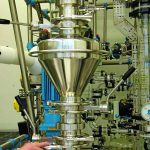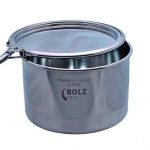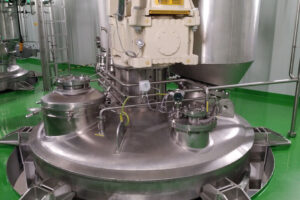Firmen im Artikel
The emission-free powder transport system (EPTS) from Bolz Intec was designed for sealed transport of small quantities of solids (powders and granules) under sterile conditions. This system consists of a centrifugally optimised central container equipped with flap valves on the loading and emptying sides as well as a modular set of attachments and sealing parts (tri-clamp). The active substance volume can range from 2 to 220 l, depending on the diameter. Various adapter elements can be mounted on the loading side, such as funnels or adapter parts which can be rendered inert and sterilised. This also applies to the outlet. The high quality of the surface, with Ra 0.25 μm on all process-side surfaces, is very important for efficient and optimal emptying. The system is thus adaptable for use with reactors, batch tanks or tablet presses, for example. The container can be filled and emptied in a protected atmosphere (glove box) or vacuum.
Emission-free powder transport
A funnel for filling and/or a CIP chamber for cleaning the entire system can be attached to the valve on the upper part of the container, while the flap valve at the outlet of the EPTS has a connection for the reactor to be filled. When filling, the CIP chamber is completely removed in order to attach the funnel. The filling funnel is flanged onto the upper part of the EPTS and the medium (powder) is added using a vacuum/suction process. The flap valve is then closed and the CIP chamber remounted, so that the EPTS can head to the reactor, where it is docked and the powder is added to the process by creating a vacuum in the reactor. If necessary, the trolley can be raised to line up with the reactor. The EPTS clean-in-place system ensures 100 % emptying and cleaning of the entire system without emissions. Integrated spray heads and rotating nozzles can be used for CIP cleaning or to ensure optimal emptying of process fluids in a closed system. The EPTS is optionally available with Hastelloy or Halar coatings. Besides silicone, other seal materials are also available, such as EPDM or PTFE (FDA compliant).
Residue-free drum emptying
When emptying containers, there is the problem of residues which are left behind. To handle this problem, a funnel with a flap valve is usually placed on the rigging of a stainless steel drum secured with a tensioning ring and turned over so that the drum can be emptied. However, experience has shown that residual quantities still remain on the funnel neck as well as on the rigging. This can be attributed to dead spaces in the design which trap residual powdered or viscous media during emptying, wasting valuable products and posing a high risk of both internal and external contamination. In addition to product loss, this also significantly increases the cleaning effort required to meet GMP and FDA regulations. Product residues are therefore a risk in terms of safety and can also hurt the bottom line.
Bolz Intec has developed a practical, multi-functional emptying system for drums explicitly for use in hygiene-sensitive areas, which optimises the dead space between the emptying cone and the drum. The specially designed funnel with a flap in various systems is fixed simply and securely to the drum with a clamping ring and a seal. Users can then resort to their normal technology for emptying. To achieve an unobstructed product flow, the part of the funnel coming into contact with the product extends into the drum, whereas previously contact was on the funnel itself. The funnel is mounted on the drum not unlike a lid, thus allowing the drum to be completely emptied. A cap with seal is used during transport and to protect the product.
The drum can be supplied with different bottoms. Tri-clamp connectors can be welded in the version with a dished bottom and foot ring. These are suitable for blasting the container with nitrogen during the emptying process (air shock) as well as for adding further product components or using measurement technologies. A CIP lance can also be easily installed either to capture the process liquid for reuse during rinsing or to reuse the drum once emptied. A stirrer is likewise possible to gently mix the product during emptying in order to prevent bridging.
Simple drum handling
The emptying system can be transported by means of a drum carriage, drum roll, drum lifter or other transport device. For safety reasons, the system has been reinforced with a footrest and a rail to protect the container when used in unprotected production processes. Correct handling can prevent damage to the drum and the tension closure. Another advantage is that since the footrest and the rail are also utilised as handles, protection and a transport aid, they facilitate the emptying process. The drum seal is tightly welded and very stable to prevent contamination. The system can be supplied in various sizes with a diameter of 315, 375, 400, 450, 500 or 560 mm. The surface is available in bright-milled, polished or electro-polished. The roughness depth is between 0.8 and 1.2 μm by default, though other roughness depths as low as 0.3 μm are possible on request. The transport and emptying system can be delivered in the following materials: 1.4301, 1.4404, 1.4435, 1.4539, or Hastelloy C22 2.4602. The silicone round-snap seals with FDA approval, USP Class 6 and BSE/TSE approval ensure a secure, airtight closure. Sealing materials such as EPDM or Viton are additionally available. The Sole Valve is used to control and steer the flow. This valve permits continuous feeding of granules and powders without material stoppage, as well as even dosage during the feeding of processing machines.
GMP-compliant lidded drums
GMP-compliant lidded drums, which are offered with volumes from 0.5 to 300 l as well as in different diameters, are well suited for storing hygiene-sensitive products in the pharmaceutical industry. They are dull WIG welded with welding filler material and without gaps. The seams are rolled flat and finely polished inside and out. They are moreover easy to clean and absolutely residue-free and exhibit high stability even at maximum load. The surfaces are polished or electro-polished for optimum product output with 0.25 μm roughness. The reusable clamping ring cover with insertable round cord seal in materials such as silicone, EPDM or Viton permits simple, airtight sealing along with the FEP-coated seals with FDA approval.
In addition to industry-standard materials such as 1.4301/AISI 304 and 1.4404/AISI 316L, drums for extreme conditions are also offered in Hastelloy C 22. Due to increasing demand for Hastelloy C 22, Bolz-Intec has now decided to put this drum into mass production. Hastelloy C 22 is very resistant to chloride ions, iodine and bromine as well as to acids like sulphuric, phosphorous or nitric.
Single-use or dedicated application
Thin-walled stainless steel such as 1.4301 is used for the best-cost stainless steel drum for single-use applications, with a diameter of 450 or 560 mm and a volume of 100 or 200 l. The drum provides very high quality, stability and breaking strength. It is priced about one-third lower than the standard stainless steel drums.
When emptying the drums, stainless steel funnels make the whole process dust-free and loss-free. The broad range of Bolz Intec funnels extends from asymmetrical and symmetrical designs to conical drums. Openings with inside diameters as small as 40 mm can be made from one piece. Both the angle and the surface are freely selectable as bright-milled/2B, polished or electro-polished. The material thickness is 1.5 mm. 60° and 90° angles are standard in conical funnels, though funnels can also be made according to specific customer requirements.
Online search: cpp0317bolzintec
Hall 1, Booth 148











